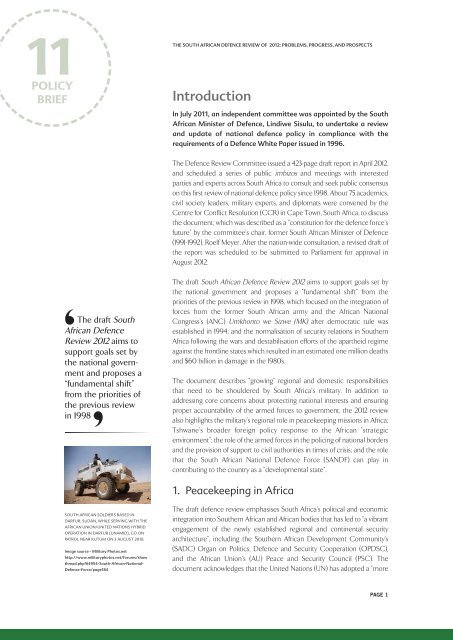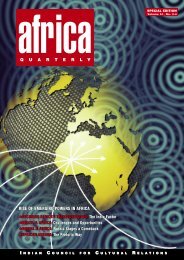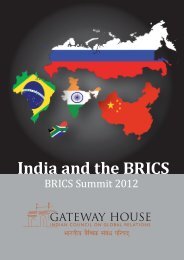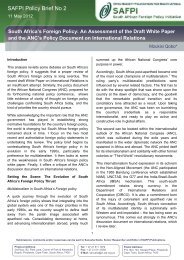Create successful ePaper yourself
Turn your PDF publications into a flip-book with our unique Google optimized e-Paper software.
11<br />
POLICY<br />
BRIEF<br />
THE SOUTH AFRICAN DEFENCE REVIEW OF 2012: PROBLEMS, PROGRESS, AND PROSPECTS<br />
Introduction<br />
In July 2011, an independent committee was appointed by the South<br />
African Minister of Defence, Lindiwe Sisulu, to undertake a review<br />
and update of national defence policy in compliance with the<br />
requirements of a Defence White Paper issued in 1996.<br />
The Defence Review Committee issued a 423-page draft report in April 2012,<br />
and scheduled a series of public imbizos and meetings with interested<br />
parties and experts across South Africa to consult and seek public consensus<br />
on this first review of national defence policy since 1998. About 75 academics,<br />
civil society leaders, military experts, and diplomats were convened by the<br />
Centre for Conflict Resolution (<strong>CCR</strong>) in Cape Town, South Africa, to discuss<br />
the document, which was described as a “constitution for the defence force’s<br />
future” by the committee’s chair, former South African Minister of Defence<br />
(1991-1992), Roelf Meyer. After the nation-wide consultation, a revised draft of<br />
the report was scheduled to be submitted to Parliament for approval in<br />
August 2012.<br />
‘<br />
The draft South<br />
African Defence<br />
Review 2012 aims to<br />
support goals set by<br />
the national government<br />
and proposes a<br />
“fundamental shift”<br />
from the priorities of<br />
the previous<br />
’<br />
review<br />
in 1998<br />
The draft South African Defence Review 2012 aims to support goals set by<br />
the national government and proposes a “fundamental shift” from the<br />
priorities of the previous review in 1998, which focused on the integration of<br />
forces from the former South African army and the African National<br />
Congress’s (ANC) Umkhonto we Sizwe (MK) after democratic rule was<br />
established in 1994; and the normalisation of security relations in Southern<br />
Africa following the wars and destabilisation efforts of the apartheid regime<br />
against the frontline states which resulted in an estimated one million deaths<br />
and $60 billion in damage in the 1980s.<br />
The document describes “growing” regional and domestic responsibilities<br />
that need to be shouldered by South Africa’s military. In addition to<br />
addressing core concerns about protecting national interests and ensuring<br />
proper accountability of the armed forces to government, the 2012 review<br />
also highlights the military’s regional role in peacekeeping missions in Africa;<br />
Tshwane’s broader foreign policy response to the African “strategic<br />
environment”; the role of the armed forces in the policing of national borders<br />
and the provision of support to civil authorities in times of crisis; and the role<br />
that the South African National Defence Force (SANDF) can play in<br />
contributing to the country as a “developmental state”.<br />
1. Peacekeeping in Africa<br />
SOUTH AFRICAN SOLDIERS BASED IN<br />
DARFUR, SUDAN, WHILE SERVING WITH THE<br />
AFRICAN UNION/UNITED NATIONS HYBRID<br />
OPERATION IN DARFUR (UNAMID), GO ON<br />
PATROL NEAR KUTUM ON 3 AUGUST 2010.<br />
Image source - Military Photos.net<br />
http://www.militaryphotos.net/forums/show<br />
thread.php?64954-South-African-National-<br />
Defence-Force/page184<br />
The draft defence review emphasises South Africa’s political and economic<br />
integration into Southern African and African bodies that has led to “a vibrant<br />
engagement of the newly established regional and continental security<br />
architecture”, including the Southern African Development Community’s<br />
(SADC) Organ on Politics, Defence and Security Cooperation (OPDSC),<br />
and the African Union’s (AU) Peace and Security Council (PSC). The<br />
document acknowledges that the United Nations (UN) has adopted a “more<br />
PAGE 1





